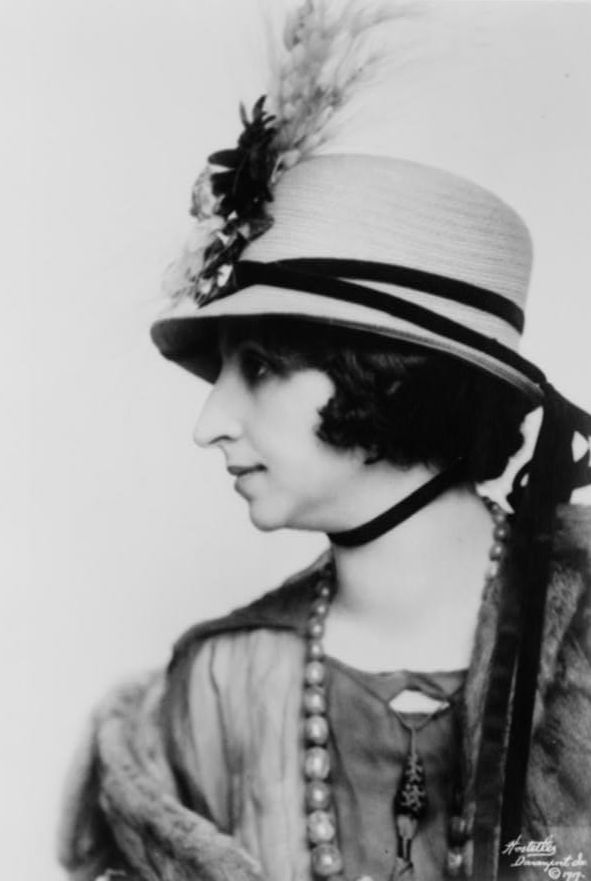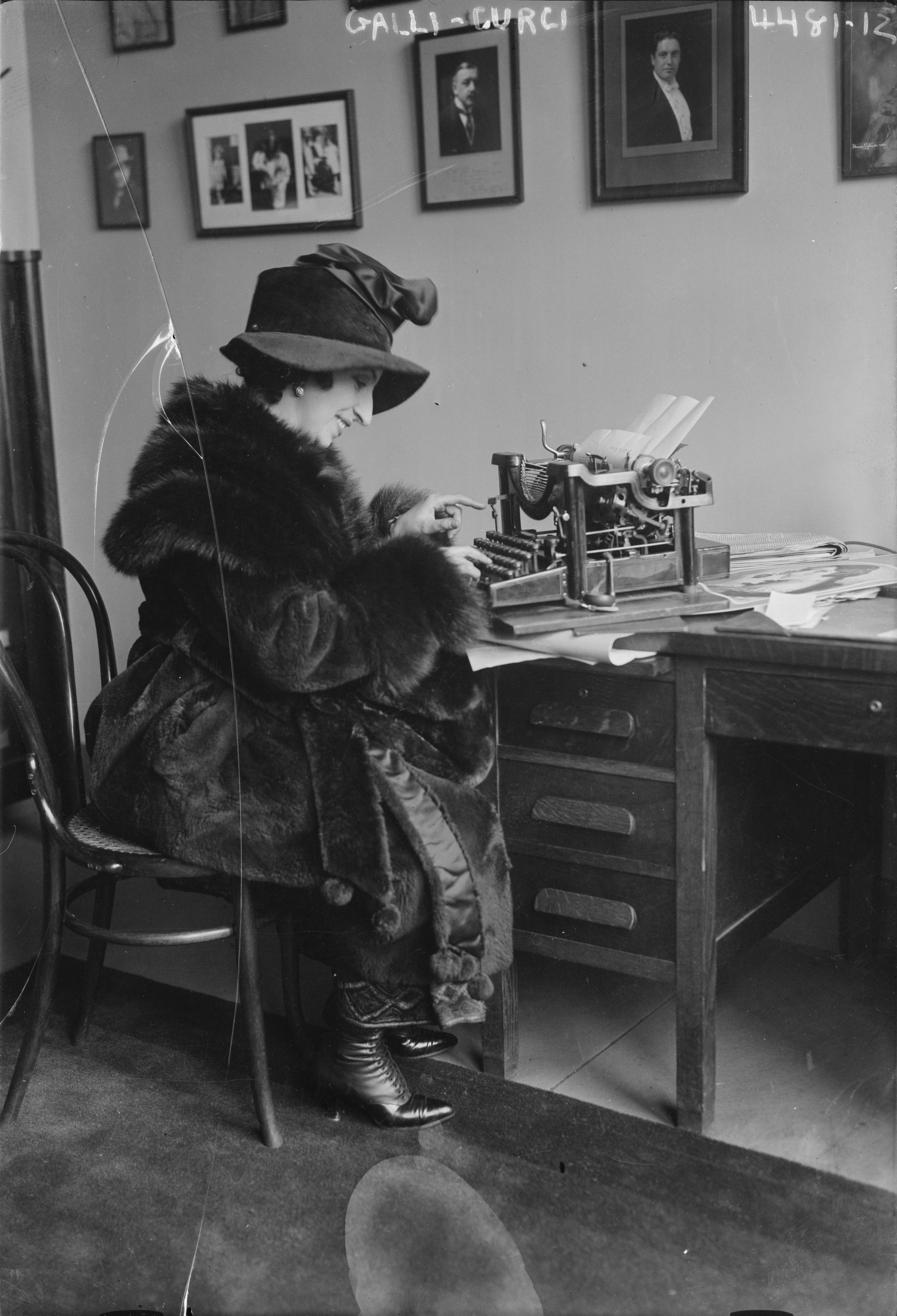Eli M. Oboler Library
Amelita Galli-Curci - Biographical Sketch
MC119
From Wikipedia, the free encyclopedia

Amelita Galli-Curci
Amelita Galli-Curci (18 November 1882 - 26 November 1963) was an Italian operatic coloratura soprano. She was one of the best regarded singers of the early 20th century.
She was born as Amelita Galli into an upper-middle-class family in Milan, where she studied piano in her youth. She was inspired to sing by her grandmother. Operatic composer Pietro Mascagni also encouraged Galli-Curci's singing career. By her own choice, Galli-Curci's singing was largely self-trained, from listening to other sopranos, reading old singing method books, and practicing piano exercises with her voice.
Galli-Curci made her operatic debut in 1906 at Trani, as Gilda in Rigoletto and she rapidly became acclaimed throughout Italy.
In 1908 she married the Marchese Luigi Curci, and added his last name to hers. They divorced in 1920 and the following year, Galli-Curci married Homer Samuels, her accompanist. In 1922 the Marchese Curci petitioned the papal council in Rome for an annulment. [1]
She toured widely in Europe and South America. In 1915 Galli-Curci sang two performances of Lucia di Lammermoor with Enrico Caruso in Buenos Aires. These were to be her only appearances in opera with the legendary tenor, though they later appeared in concert and made a few recordings together. Galli-Curci arrived in the United States in 1916 a virtual unknown. Her stay was intended to be brief, but the acclaim she received for her performance as Gilda in Rigoletto in Chicago, Illinois on November 18, 1916 (Her 34th birthday) was so wildly enthusiastic that she accepted an offer to remain with the Chicago Opera Company. She was a member of the company through 1924. Also in 1916, Galli-Curci signed a recording contract with the Victor Talking Machine Company and recorded exclusively for the company until 1930. In 1921 Galli-Curci joined the Metropolitan Opera in New York remaining with this organization until her retirement from opera in 1930.

Amelita Galli-Curci in fur coat
Forms part of: George Grantham Bain Collection (Library of Congress).
Galli-Curci built and maintained an estate called Sul Monte in Highmount, New York, where she summered for many years until she sold the estate in 1937.[2] [3]In the nearby village of Margaretville a theater was erected and named in her honor. She returned the favor by performing there on its opening night. [4]
Galli-Curci was a student of the Indian meditation and yoga teacher Paramhansa Yogananda.[5] She wrote the forward to Yogananda's 1929 book Whispers from Eternity.[6] [7]
Weary of opera house politics and convinced that opera was a dying art form, Galli-Curci retired from the operatic stage in January 1930 to concentrate instead on concert performances. Throat problems had plagued her for many years and she underwent surgery in 1935 for the removal of a thyroid goiter. Great care was taken during her surgery, which was performed under local anethesia; however, her voice suffered following the surgery. A nerve to her larynx, the external branch of the superior laryngeal nerve, is thought to have been damaged, resulting in the loss of her ability to sing high pitches. This nerve has since become known as the "nerve of Galli-Curci."
In 2001, Crookes and Recaberen "examined contemporary press reviews after surgery, conducted interviews with colleagues and relatives of the surgeon, and compared the career of Galli-Curci with that of other singers" and found that her vocal decline most likely did not result from a surgical injury. [8]
In 1936, Galli-Curci made her ill-advised return to opera as Mimi in La Boheme in Chicago. It was painfully clear that her singing days were over and after a few more recitals she went into complete retirement living in California. She began teaching singing privately up until her death in November 1963 at the age of 81. Among her students was soprano Jean Fenn.
Bibliography
- The Last Prima Donnas, by Lanfranco Rasponi, Alfred A Knopf, 1982. ISBN 0-394-52153-6
- Discography of Amelita Galli-Curci on Victor Records from the Encyclopedic Discography of Victor Recordings (EDVR)
Notes
1. "Seeks Annulment of His Marriage to Galli Curci". Catskill Mountain News: p. 4. 10 February 1922. http://history.catskill.net/1922/1922-02-10-0004.pdf (URL no longer links to document).
2. "Galli-Curci Tells of Her Simple Life". The New York Times. 8 November 1921. http://query.nytimes.com/gst/abstract.html?res=9D05E0DB1431EF33A2575BC0A9679D946095D6CF.
3. "Madame Galli-Curci Sells Home at Highmout". Catskill Mountain News: p. 1. 2 July 1937. http://history.catskill.net/1937/1937-07-02-0001.pdf (URL no longer links to document).
4. Clarke A. Sanford (1 September 1922). "Galli Curci Theatre Has Notable Night". Catskill Mountain News: p. 1. http://history.catskill.net/1922/1922-09-01-0001.pdf (URL no longer links to document).
5. *Ferguson, Charles W. (1930). The New Book of Revelations: The Inside Story of America's Astounding Religious Cults. New York: Doubleday, Doran, & Company., p. 460.
6. Yogananda, Swami (1929). Whispers from Eternity. Los Angeles: Self-Realization Publishing., forward.
7. Yogananda, Swami. "Online Whispers from Eternity, first edition". http://www.whispersfrometernity.org/contents/foreword.html. Retrieved 2008-01-23.
8. Crookes, Peter (April 2001). "Injury to the Superior Laryngeal Branch of the Vagus During Thyroidectomy: Lesson or Myth?". 233(4). Annals of Surgery.